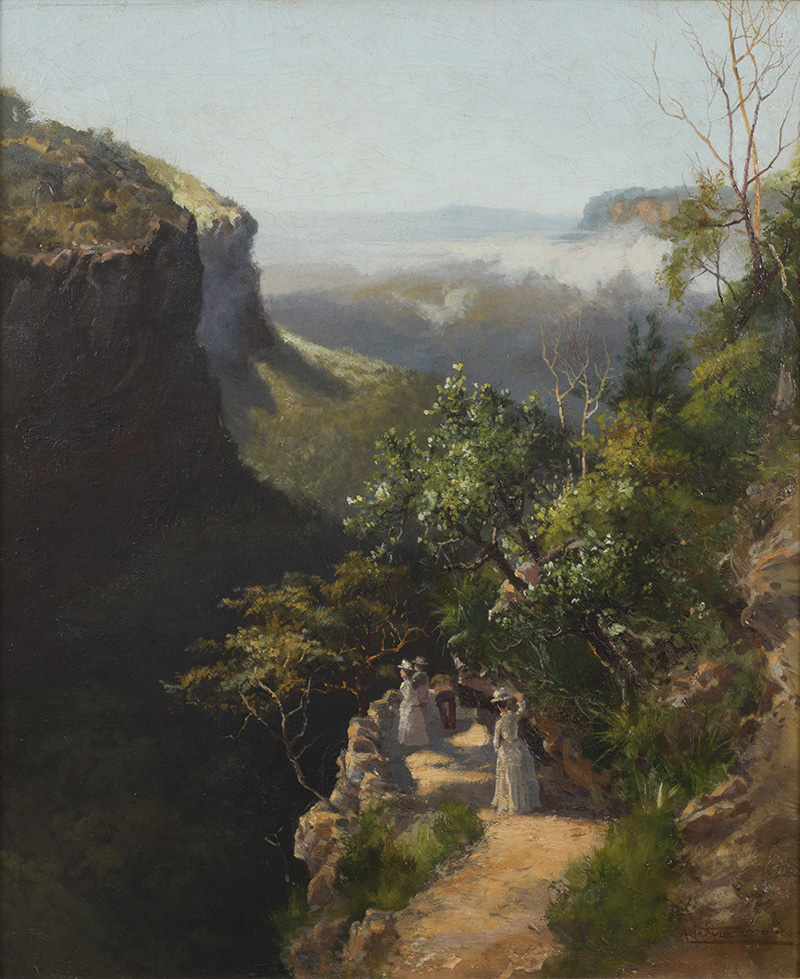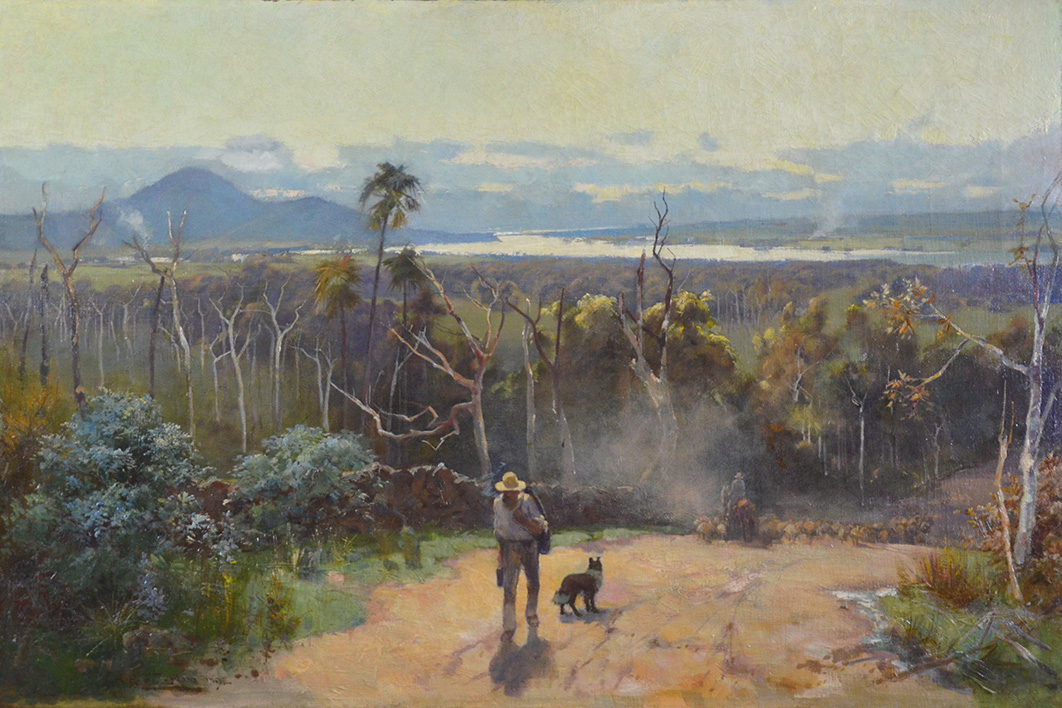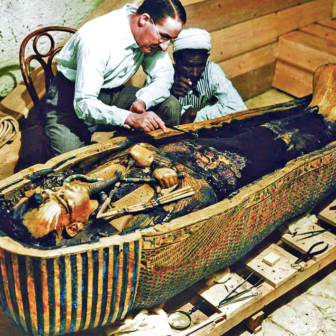“Australian impressionism” is the Australian art world’s most powerful brand. It sells like no other in our major galleries, private dealerships and leading auction houses. I’ll wager that you, too, have acquired over the years some impressionist “merch” — calendars, fridge magnets, catalogues, posters, postcards or tea towels.
One of the powerful engines driving this branding has been the blockbuster exhibition. And so, just as our pandemic gloom has begun to lift, we’ve been offered two generous helpings of this cultural comfort food. The Art Gallery of New South Wales’s Streeton was thronged right up to its closing in mid February. And now an even larger show, She-oak and Sunlight: Australian Impressionism, has opened at the National Gallery of Victoria.
Why can’t we get enough of the iconic paintings of Tom Roberts, Arthur Streeton and their followers? The legend of the movement’s origins in Heidelberg, its defiant birth in the 9 by 5 exhibition of 1889 and its adoption as a signifier of Australian national identity certainly has something to do with Australian impressionism’s hold on our imagination. The very notion of Australian impressionism implies that here at last was a style we could call our own, combined with a cheeky assertion of kinship with the glamour of Paris.
But the legend’s deepest anchor lies in the paintings themselves, specifically the landscapes of Arthur Streeton. As the historian Keith Hancock observed nearly a century ago, Streeton’s pictures were already a “national habit,” a vision of an unchanging Australian Arcadia. Part of the works’ continuing enchantment is that, as Paul Simon once sung about “Kodachrome,” they still give us “the nice bright colours,” the “greens of summer,” and make us think that “all the world’s a sunny day.” And who would not want to have some of Streeton’s sunshine in their lives at this moment?
Australian impressionism is also an enduring paradigm of Australian art history, one that was firmly established in Bernard Smith’s seminal book, Australian Painting, 1788–1960. During the past six decades our art historians have offered many refinements and reassessments of the origins, character and significance of the work of Streeton, Roberts and their contemporaries, including in recent years Clara Southern, Jane Sutherland and other female artists. There’s even been a prolonged and productive debate about whether it’s meaningful to speak of their style as impressionist.
Yet for all their passion and erudition, the starting point for most scholars of the period 1885–1900 — including Australia’s social and cultural historians — remains a focus on the usual suspects and their most favoured medium of oil on canvas.
But what if we shifted the angle of vision on this most fabled era in Australian art history and saw it through the eyes of a less familiar figure?
This is what I’ve been doing for more than a decade as I’ve researched the art and life of one A. Henry Fullwood (1863–1930). Fullwood (like most British-Australian artists prior to 1900, including Tom Roberts) was English-born and trained before immigrating to Sydney in 1883. From then until 1900 he was probably the most viewed artist of his generation thanks to his work as an illustrator for the Picturesque Atlas of Australasia, the Sydney Mail, the London Graphic and the Bulletin.
A close friend and ally of Roberts and Streeton, Fullwood was also regarded as a leading impressionist painter. Indeed, the critic and artist David Souter went so far as to assert at the time that Fullwood was “the most Australian of all our Australian painters.” Between 1900 and 1920 Tom, Arthur and “Remus” — as Fullwood was known to his mates — decamped to London, becoming honoured members of the Chelsea Arts Club before working as medical orderlies and official war artists during the Great War. All in all, Fullwood was a well-known and highly respected artist.

A. Henry Fullwood’s Prince Regent’s Glen, Wentworth Falls (1888). Denis Savill Collection/Macquarie University Art Gallery
So why has his star so waned while his friends have gone on to become icons of Australian art? Put briefly, his art and career don’t easily align with the legend, paradigm or brand of Australian impressionism. If only he had been born in Australia, worked in Melbourne, and camped with Roberts and Streeton in Heidelberg, Remus might still be more widely remembered today.
But it’s not just Fullwood whose contributions to Australian art have been marginalised. The neglect extends to all of his fellow artist-illustrators working in Sydney at that time, including the estimable Julian Ashton and Frank Mahony. Apart from their misfortune not to have been Marvellous Melburnians, their status as “artists” has been anachronistically diminished by their well-paid work as “illustrators.” Their ephemeral black-and-white art has been largely ignored or devalued, and even their distinguished work as watercolourists, printmakers and painters is seen as of secondary importance to the now-iconic oils of Roberts, Streeton and their circle.
What difference would it make to our understanding of Australian art in the Heidelberg era (including Australian impressionism) if we enlarged our field of vision to include the contributions of Sydney’s art-workers who, in Bernard Smith’s judgement, helped to make Australia “one of the most important centres of black-and-white art in the world” during the second half of the nineteenth century?
This is the question at the heart of A Nation Imagined: The Artists of the Picturesque Atlas, an exhibition that recently opened at the National Library of Australia. Produced in partnership with the Art Gallery of New South Wales, the NLA show highlights both the Atlas as a landmark moment in the history of Australian art and the contributions of three of its settler-colonial artists — Ashton, Fullwood and Mahony — to the advancement of what journalist James Smith described in 1887 as “a distinctive school of landscape painting.”
A Nation Imagined, which I co-curated with Natalie Wilson, begins by foregrounding the role of the illustrated press’s wood-engraved art in shaping the visual culture of the Victorian era. The high point of this art form was The Picturesque Atlas of Australasia. Produced between 1886 and 1889 in forty-two parts, it brought to Australia a small army of American artists, engravers, cartographers, printers and salesmen who collaborated with local authors and illustrators to create possibly the most beautiful book ever published in Australia.
The chief selling point of the Atlas was its 800 original engravings which, combined with its text and maps, offered a proudly settler-colonial view of Australia’s history, achievements and prospects. The Atlas consolidated a distinctive iconography whose landscapes, seascapes and townscapes emphasised the productivity as well as the beauty and pride of an emerging nation. Its heroes were the men — governors, explorers, miners and pastoralists — who made Australia. While the Atlas’s writers and artists marginalised the history and suffering of First Nations peoples, they ignored altogether the contributions of convicts and white women.
On the strength of its settler-colonial iconography, the Atlas was acknowledged in 1300 newspaper articles between 1886 and 1889 as marking “the birth of art beneath the Southern Cross.” Compared with the prolonged attention lavished on the Atlas’s artists, the 9 by 5 exhibition was a mere flash in the pan. Visitors to A Nation Imagined will have the chance to judge for themselves the aesthetic interest of the many original sketches and engravings on display.
The Atlas transformed Ashton, Fullwood and Mahony almost overnight into three of settler-colonial Australasia’s most famous artists. Ashton used his fame and considerable political skills to take over the Art Society of New South Wales. Between 1889 and 1898, as a trustee of the National Art Gallery of NSW, he successfully lobbied for £500 to be spent annually on the purchase of Australian art. Sydney was now well on its way to becoming Australia’s art capital.
The younger Fullwood and Mahony also went from strength to strength, even collaborating to produce art for both the illustrated press and private patrons. Fullwood was appointed a staff artist for both the Sydney Mail’s Illustrated Supplement — the forerunner of today’s Good Weekend — and the London Graphic. Mahony became the Bulletin’s premier artist of outback life and humour, illustrating the books of its leading writers, including Henry Lawson and Steele Rudd. He was a fine painter of animals, and Sydney’s National Gallery purchased several of his paintings, along with those of his good mate Fullwood.
Not content with these local successes, Ashton orchestrated the placement of Australian art onto the world stage, initially at the 1893 World’s Columbian Exposition in Chicago and, five years later, at the first exhibition of the work of the “Australian school” in London. Ashton was far and away the most influential champion of Australasia’s settler-colonial artists, and in A Nation Imagined it’s at last possible to weigh up his distinctive artistic contributions alongside the sketches and paintings of his fellow Atlas artists, Fullwood and Mahony.
Two other beneficiaries of Ashton’s growing influence were Tom Roberts and Arthur Streeton, who came to Sydney in the early 1890s as economic refugees from Melbourne. The National Gallery of Victoria refused to buy their works, but its NSW counterpart was prepared to do so. The two Victorians soon became active members of Sydney’s burgeoning artist colony, finding in Fullwood a fellow impressionist who was glad to share with them his networks, patrons and tradecraft. This was the context that enabled Roberts and Streeton to produce some of their most iconic works.
When the narratives of the NLA’s A Nation Imagined and my work on Fullwood are combined with those attached to the legend, paradigm and brand of Australian impressionism, the result will be a richer and much-enlarged story about this fabled era in Australia’s art history.
For a start, we can begin to see that Australian impressionism was part of a much wider settler-colonial art movement that embraced both Melbourne’s painters and Sydney’s artist-illustrators. Whatever the medium, their work reflected dominant views of Australia’s history, achievements and identity, their pictures defined by their celebration of whiteness, masculinity and settlers’ claims to indigeneity by virtue of their possession of Australia’s sunburnt country. What remained outside their frames were the dispossession of First Nations’ peoples and the lives and labour of settler women.
In addition to sharing a common iconography, Sydney’s and Melbourne’s artists fed off a similar set of artistic influences, largely emanating from London and reinforced by the English-born and -trained artists who dominated these colonial outposts of Britain’s imperial art world. These would include such French-inflected British art practices as plein air painting and tonal realism. In other words, we might start talking about British-Australian impressionism and its distinctive contribution to British art history.
From this perspective, Roberts, Streeton and Fullwood’s move to London can be seen as not the ending but the completion of Australia’s settler-colonial art movement; its homecoming to the heartland of British art. The art they created in England was integral to both their cultural and imperial identities and their artistic development.
The movement ultimately culminated in these artists’ wartime service. It was particularly fitting that Australia’s war art scheme drew on the skills of painters like Streeton but still more heavily on artist-illustrators like Fullwood, whose pictures proved perfect illustrations for Charles Bean’s creation of the Anzac legend — yet another enduring evocation of a settler-colonial worldview.
But my suggested reframing of Australian art history will only work if the art of illustration is accepted as an essential component of how we tell its story. This will involve much debate and research, including the publication of a biography of Julian Ashton that does justice to his multiple roles in shaping Australia’s settler-colonial art movement.
Meanwhile, lovers of Australian art and history have the unique opportunity to compare the work of Sydney’s and Melbourne’s settler-colonial artists, which will be on view, respectively, at the NLA in Canberra until 11 July and the NGV in Melbourne until 22 August. Let the conversation begin! •




